The bright green goop is the very bottom of the ocean food chain. It’s also the latest delicacy.
What disturbed chef Angel León most about Spanish fishermen was all the unwanted species they tossed back into the ocean. High-value species went to market; the rest went overboard. These dead fish would never be coming up in their nets again. Bycatch is by no means confined to Spanish fisheries (an estimated 1 million tons of discarded seafood goes back into the water in the European Union alone) and it’s the unappetizing downside to eating at the top of the marine food chain. So León, the chef at Aponiente, a Michellen-starred restaurant in Puerto de Santa María, Spain, started asking fishermen for everything–even going as far as using fish eyeballs as a thickening agent. Then León went beyond mere fish and began championing the bright-green organism that serves as the very basis of the marine food web: phytoplankton, or la leche del mar (the milk of the sea).
Phytoplanktonic blooms cover the world’s oceans and the ubiquitous microscopic organisms are like micro-greens of the sea, except these unicellular creatures are as important as all the world’s trees in using solar energy to fix atmospheric carbon dioxide and feed the world. In the spring, when the North Atlantic blooms, predators large and small migrate thousands of miles for a phyto-smorgasbord. Because the plant-like wanderers have little control over where they drift, phytoplankton responds quickly to changes in the environment, acting as a barometer for oceanic health, from warming Arctic oceans to phosphorus runoff from dish soap and agricultural fertilizer.
Wild species can be foraged and harvested, but specific species of phytoplankton are also cultured at labs like Fitoplancton Marino in El Puerto de Santa María. “It’s not like you can go to the oceans and go, ‘Let’s harvest it and eat it,’” Carlos Unamunzaga, the lab’s general manager, says. “Even if it was possible to harvest from the wild, you don’t want deplete the ocean or a marsh.” (Indeed, similar efforts to harvest krill–a micro-crustacean–for its omega-3 fatty acids depleted supplies in the Southern Ocean off Antarctica.)
via FastCoExist – Peter Smith
The Latest Streaming News: Plankton updated minute-by-minute









